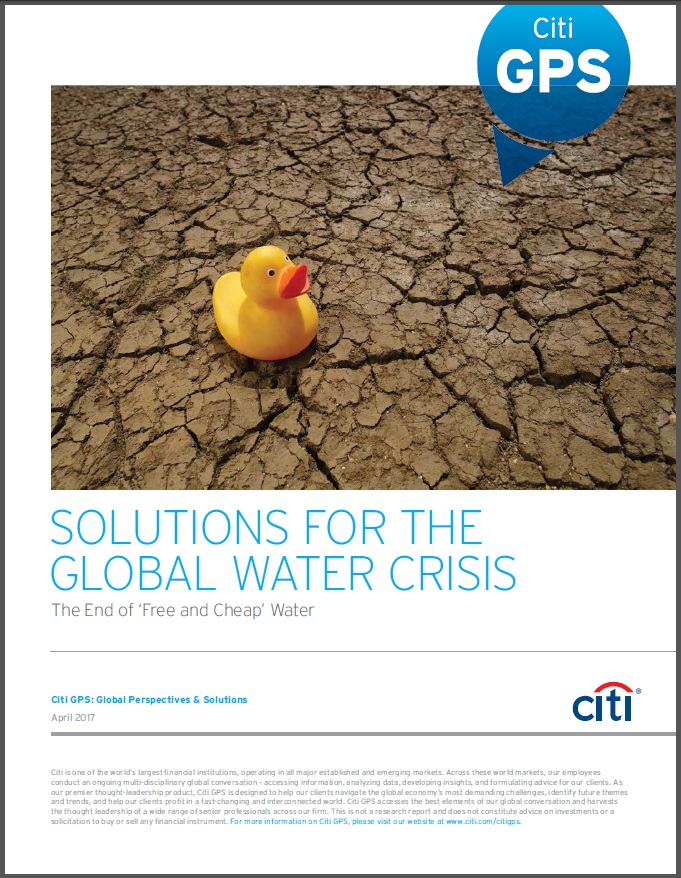Solutions for the global water crisis
What is Water?
It is no secret that the world confronts multiple critical challenges in the management of water. Nor is there any hiding from the fact that these challenges arise across the chain, from source to end use, with huge issues associated with distribution. There are also multiple conflicting challenges of access and ownership in each of these three areas and they are exacerbated by the many challenges the world faces in providing adequate potable water. Most of the challenges to designing policies to improve the supply and distribution of water and to adjudicate conflicts over end-use stem from conflicting answers to the question, “What is water?”
To an economist there is a temptation to define water as a commodity and suggest it should be priced according to market principles of supply and demand. Like other commodities, it is consumed and therefore should be priced in terms of its scarcity. Abundant freshwater and ease of water access in primitive societies enabled water to be treated as a free good.
Scarcity should provide a pricing mechanism or a distributive regulatory mechanism for sharing. In society today, one of the principle issues for market pricing relates to tapping into seawater to provide freshwater where scarce. The world has an enormous abundance of seawater, which can substitute for freshwater in some of its uses (for example, in hydrocarbon exploitation, when water injection is desirable to improve production and productivity). More importantly, seawater can be a source of freshwater via desalination and the most effective way for that to work would be to assure that market pricing is at work to encourage private sector involvement.
One problem is that while water is in some respects a commodity, in other respects it is a very special kind of commodity — similar to food and fuel (especially electricity) — where access is deemed a basic individual right, raising conflicting paths for how it should be dealt with. Governments are often tempted to assure “equity” or fairness to access certain commodities, which are deemed to be fundamental, both to the concept of equity and of well-being. More often than not issues of accessibility are deemed to require straightforward distributive mechanisms, including utility model pricing. At times re-distributive mechanisms may be deemed to be appropriate, through subsidies or differential treatment that would conflict with pricing principles associated with traditional commodity markets or even utility markets.
Access to water is also often seen as an issue related to public goods and even a specific category of special goods, a “commons”. Regulation of commons, whether water, the atmosphere, the Arctic, or the oceans, is an area that invites dramatic and conflicting differences of views that come down to a few key questions: How should the commons be shared? Who pays for use of the commons? How can damage to the commons be regulated? Pricing and payments principles also can be sources of conflict. Does the polluter or the polluted pay for clean-up, for example, and in what measure? The misuse of water is a classic case of the tragedy of the commons, an economic theory in which every individual tries to reap the greatest benefit from a given resource. Demand eventually overwhelms supply, and soon every individual who consumes the resource harms others who cannot readily access it. The traditional way of resolving this is to have governments or some regulatory bodies provide this public good. Where regulation is not in place or not effectively enforced, it could go the way of over-fishing, where the fishing stock has collapsed in some cases in the Atlantic and elsewhere.
Two sources of inevitable conflict need to be dealt with and adjudicated, through a combination of agreement and regulation. One source is related to water use and is exacerbated by drought conditions, as has recently been the case in California. What are the rights of the agricultural sector versus the energy sector, the two largest water users in the United States? In general, biodiversity and the environment, along with recreational use, have in many cases come ahead of these two sectors in public perception. Against those rights, how do claims for potable water in cities become adjudicated? Another source of friction relates particularly to access to river water and claims to access the water when different jurisdictions are involved, sometimes within the same country (e.g. the Colorado River) and sometimes across countries (e.g. historically the Danube, but increasingly in water scarce emerging markets). The U.S. and Canada have signed treaties to make this work, but countries that have less friendly relationships with each other have more difficulties coming to terms and the result can be a military conflict over water.
As scarcity of water supply and adequacy of distribution have emerged as critical global problems, so too have issues come to the fore related to adequacy and integrity of water reservoirs, regulations on water use, water disposal, and water recycling. Wastewater is a similarly critical subject because its disposal and recycling involve the pricing of externalities and ultimately circles back to the issue of water use. Since “what is water” is a mixture of all of the concepts described above, regulation and pricing have become critical and urgent matters for efficient solutions. Given that water, like electricity, is a more local than a regional or global phenomenon, regulation can become extremely complex. Few governments have done what Israel has accomplished (see page 120) and declare that the government has the property rights to all water above or below the ground including rain water. That facilitates pricing and usage considerably. Elsewhere it remains a struggle to find a way to adjudicate conflicting claims while at the same time rationing existing fresh water supply, conserving it, and finding ways to grow it.
To download the full report, please click here.

